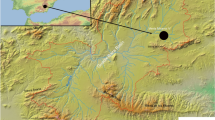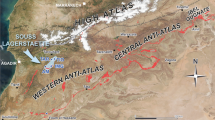Abstract
THE Ubeidiya Formation1 is known from three localities (Fig. 1) within the Jordan Valley, where it is steeply tilted, faulted and folded2,3. It is rich in prehistoric remains, representing the Developed Oldowan and Early Acheulean4. The Ubeidiya Formation is important in the Pleistocene history of the Jordan Valley for two reasons: it is the youngest sedimentary sequence to be severely affected by tectonic movements of the graben, and it contains the oldest human implements ever found in the Middle East.
This is a preview of subscription content, access via your institution
Access options
Subscribe to this journal
Receive 51 print issues and online access
$199.00 per year
only $3.90 per issue
Buy this article
- Purchase on Springer Link
- Instant access to full article PDF
Prices may be subject to local taxes which are calculated during checkout
Similar content being viewed by others
References
Picard, L., and Baida, U., Proc. Isr. Acad. Sci. Hum., 4, 1 (1966).
Picard, L., Geol. Soc. Amer. Sp. Paper, 84, 337 (1965).
Stekelis, M., et al., Bull. Res. Counc. Isr. G., IX, 4, 175 (1960).
Stekelis, M., et al., Archaeological Excavations at Ubeidiya, 1964-1966 (Isr. Acad. Sci. Hum., Jerusalem, 1969).
Blanckenhorn, M., Palaeontographica, 44 (1897).
Picard, L., Structure and Evolution of Palestine (Hebrew University, Jerusalem, 1943).
Picard L., and Baida, U., Geological Report on the Lower Pleistocene Deposits of the Ubeidiya Excavations (Isr. Acad. Sci. Hum., Jerusalem, 1966).
Horowitz, A., Upper Pleistocene-Holocene Climate and Vegetation of the Northern Jordan Valley, Israel (Hebrew University, Jerusalem, 1968).
Bar Yosef, O., in Pleistocene Stratigraphy in Israel (edit. by Horowitz, A.), 16 (The Isr. Pleist. Assn., Jerusalem, 1970).
Tchernov, E., in ref. 9.
Bar Yosef, O., and Tchernov, E., On the Palaeoecological History of the Site of Ubeidiya (Isr. Acad. Sci. Hum., Jerusalem, 1972).
Horowitz, A., Geol. Surv. Isr. Rep., P/3/68 (1968).
Bender, M. L., and Kaufman, A., Isr. J. Earth Sci., 20, 113 (1971).
Horowitz, A., Isr. J. Earth Sci. (in the press).
Leakey, M. D., in Background to Evolution in Africa (edit. by Bishop, W. W., and Clark, J. D.), 417 (Chicago, 1967).
Leakey, M. D., Olduvai Gorge (Cambridge, 1971).
Siedner, G., and Brenner, I., Earth Planet Sci. Lett. (in the press).
Isaac, G. Ll., in Calibration of Hominoid Evolution (edit. by Bishop, W. W., and Miller, J. A.), 381 (Toronto, 1972).
Horowitz, A., Pollen et Spores, XIII, 2, 255 (1971).
Author information
Authors and Affiliations
Rights and permissions
About this article
Cite this article
HOROWITZ, A., SIEDNER, G. & BAR YOSEF, O. Radiometric Dating of the Ubeidiya Formation, Jordan Valley, Israel. Nature 242, 186–187 (1973). https://doi.org/10.1038/242186a0
Received:
Issue Date:
DOI: https://doi.org/10.1038/242186a0
This article is cited by
-
The lower paleolithic of the Near East
Journal of World Prehistory (1994)
-
Age of early Acheulian industries from the Peninj Group, Tanzania
Nature (1974)
-
Radiometric ages of late Cainozoic basalts from northern Israel: chronostratigraphic implications
Nature (1974)
Comments
By submitting a comment you agree to abide by our Terms and Community Guidelines. If you find something abusive or that does not comply with our terms or guidelines please flag it as inappropriate.



